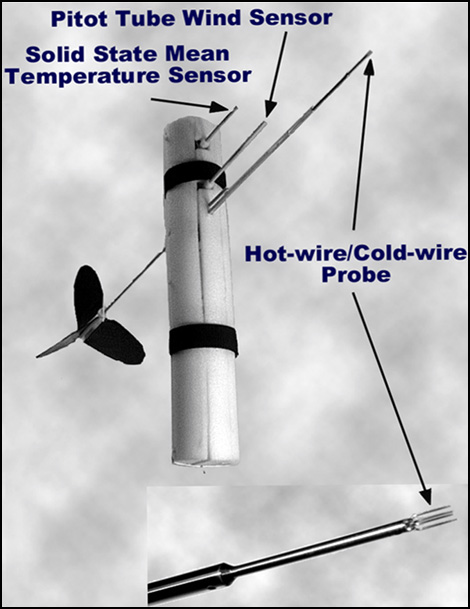CIRES Turbulence Sensor:
Temperature & Velocity
The turbulence package was developed, and over the past few years perfected, to be used with the TLS and provide -resolution insitu measurements of temperature, velocity, and turbulence (high resolution profiles and/or time series).
The fast-response fine-wire cold-wire (CW) and hot-wire (HW) probes that equip each turbulence package provide high-resolution (high frequency channels sampled at 1 kHz) measurements of temperature and velocity from which turbulence statistics can be extracted (temperature structure constant CT2 and energy dissipation rate ε),…

High-frequency and low-frequency fluctuations of temperature and velocity are recorded with the fast-response cold-wire (CW) temperature and hot-wire (HW) velocity sensors respectively. For calibration purposes, the low-frequency temperature and velocity changes are also archived with a low-frequency response Pitot-tube velocity sensor vanned into the wind, and with a slow-response solid-state temperature sensor. After calibration, the TLS provides reconstructed temperature and velocity signals which encompass both the low-frequency and the high-frequency fluctuations.
In the figure below, the middle panel shows the calibrated high-pass filtered temperature fluctuations measured by the cold-wire probe of the CIRES turbulence package. The bottom panel shows the total reconstructed temperature time series which now includes the changes of temperature at all time scales without loss of resolution at the high-frequencies.

In the first version of the turbulence package, high pass filtered CW and HW voltages were typically sampled at 200 Hz. Recent advances in electronic circuits (digitizing boards) and flash memory now permit to sample the channels at a rate of 1 kHz permitting to fully resolve the dissipation range of turbulence (past the Kolmogorov microscale, see structure function).
The absolute accuracy of the temperature measurements is better than 0.5 K while the accuracy of its fluctuations is better than 2%. For velocity, the absolute accuracy is better than 1 m s-1 while the accuracy of the slope of the calibration curve is better than 5%. The reconstructed high-resolution temperature and velocity signals are highly suitable for computing accurate turbulence statistics over short time scales (every second or less). |



